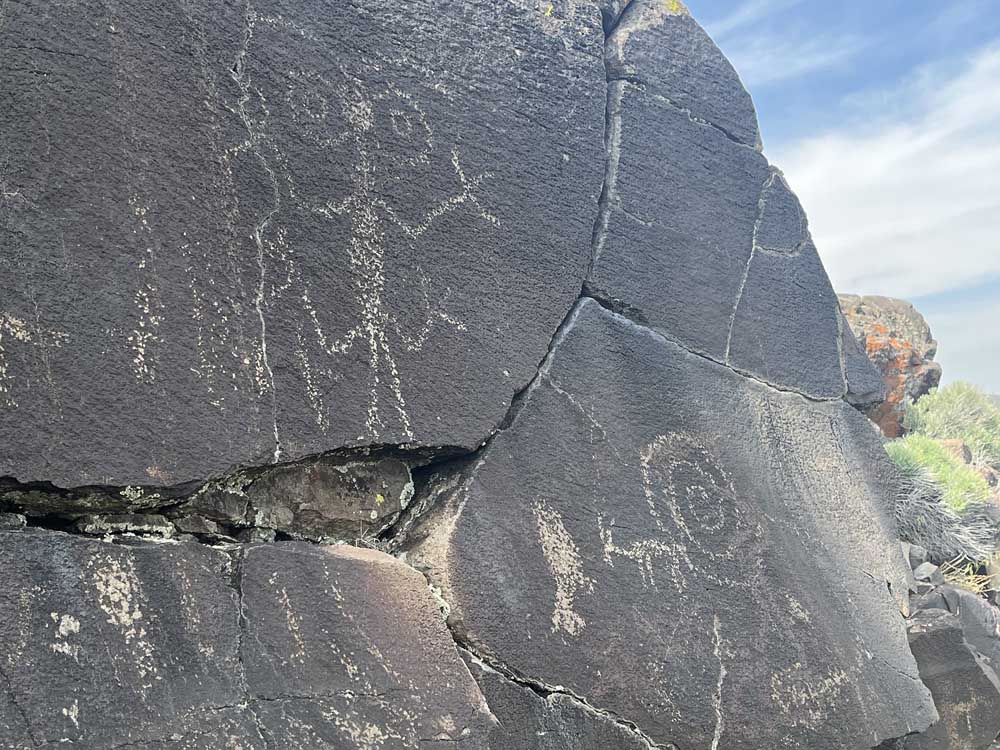Petroglyphs of Hart Mountain spur the imagination
Published 8:00 am Thursday, June 29, 2023

- Images side-by-side on basalt cliffs above Petroglyph Lake.
HART MOUNTAIN NATIONAL ANTELOPE REFUGE — We spent the morning gawking at a profusion of multi-colored wildflowers.
The high desert open spaces at the Hart Mountain National Antelope Refuge northeast of Lakeview was beautifully and unusually surreal — a landscape made lush and colorfully brilliant thanks to a snowy winter and wet spring. It’s a temporary, seasonal beauty, one we wanted to experience and appreciate.
There’s much to see and do at Hart Mountain, a refuge created to serve “as a range and breeding ground for the antelope (pronghorn) and other species of wildlife.” We hoped to see — and a day later did see — pronghorn. But there was something else to see, remnants of the distant past.
After returning to our hot spring campsite, we drove to a locked gate by a “Petroglyph Lake” sign. For years it was possible to drive about 1.5 miles on the gravel road to a parking area. The road was closed several years ago but remains open to hikers, bikers and equestrians.
The trail ends at Petroglyph Lake, but the true destination is the petroglyphs carved and scraped on the basalt cliff above the lake’s west shore. It’s believed the petroglyphs — “petro” meaning stone or rock and “glyph” meaning to carve — were created more than 10,000 years ago. The ancient paintings include animalistic figures, unusual configurations and stick-like “people.”
The genesis of Hart Mountain’s petroglyphs evokes speculation. As one “expert” wrote, “Because modern Oregon tribes have no similar painting traditions or legends, the petroglyphs may well be the work of a different people — a mysterious, earlier culture that hoped to communicate with the spirit world through symbolic messages at sacred sites. One of those sacred places must have been this small lake on the vast desert plateau atop Poker Jim Ridge. In what is now the Hart Mountain National Antelope Refuge, nearly 100 drawings decorate the basalt ledge ringing Petroglyph Lake’s western shore.”
From the path that borders the lake, we spotted and followed a faint trail up to the cliffs and found an array of petroglyphs, some in groups of a half-dozen or more, others by themselves. Some were abstract leave-it-to-your-imagination figures. Others in geometric designs. It’s believed some depict animals that were hunted for food, while others might represent the spirit world. Some believe the petroglyphs may have no mystical meaning but are simply a prehistoric form of graffiti. Whatever, they are the stuff of fascination and imagination.
We followed the faint path along the rimrocks and rock outcrops, some colored with lichen, finding more and more petroglyphs, some in the outline of pronghorn, others stick-like people. Two side-by-side figures seemed to have their arms joyfully reaching out. Another had an owl-like face. Yet another appeared to be a person falling forever down-down-down. Others resembled circular bullseyes. Among the most distinct and preserved is what might be imagined as a giant four-legged bug.
I’ve made several visits to the site, but with patience and a partner willing to continue the search, this day proved a bonanza. We didn’t count how many, but it was easily 50 or 60 or more.
Importantly, we looked but didn’t touch. Even the touch of a hand or finger could cause damage.
Once back at the car we drove to the hot spring. The 8-by-11-foot pool, which is surrounded by a rustic rock wall, offers 102-degree water. After hiking more than nine miles on our day’s two outings, the spring’s warm water was soothing and appreciated.
Among those who’ve appreciated Hart Mountain was William O. Douglas, a U.S. Supreme Court Justice. In his 1960 book, “My Wilderness: The Pacific West,” a chapter features Hart Mountain. As he wrote, “This is a land to possess and embrace. It is a land to command as far as the eye can see.”
At Hart Mountain, there’s much to see, possess and embrace.
To get there from Lakeview, the nearest town, take Highway 395 north 4.7 miles and turn east on Highway 140 west for about 15.5 miles. At a fork in the road, turn north onto the Plush Cutoff Road (Lake County Road 3-13). Follow it about 18.5 miles to Plush, which has combination store, diner, gas station, tavern. Continue through town nearly a mile, then turn right on Hart Mountain Road 3-12 past the Warner Valley Wetland (restrooms) and Camp Hart Mountain (restrooms, camp sites, interpretive signs). About 13.5 miles of Road 3-12 is paved, while the remaining 9.5 miles to refuge headquarters/visitor center is a maintained gravel road.
For more information, visit the Hart Mountain website at www.fws.gov/refuge/hart-mountain-national-antelope or call the refuge headquarters at 541-947-2731 or the Sheldon-Hart National Wildlife Refuge headquarters at 541-947-3315.






